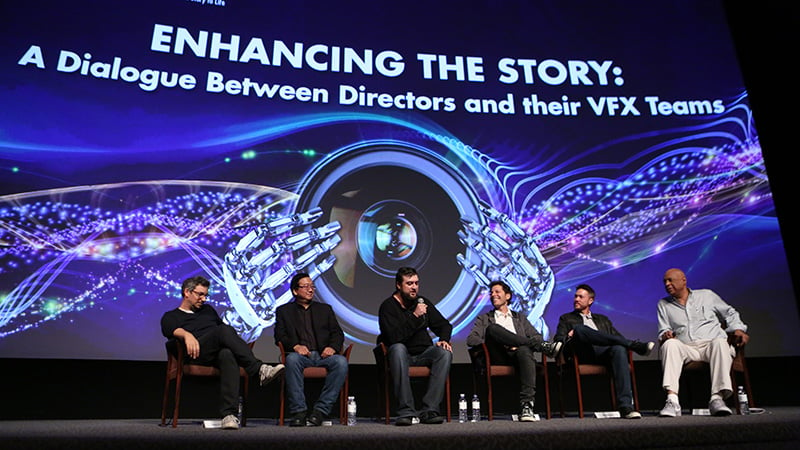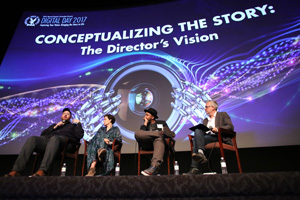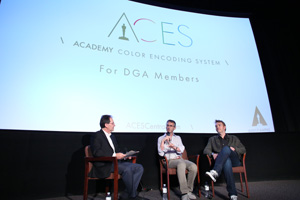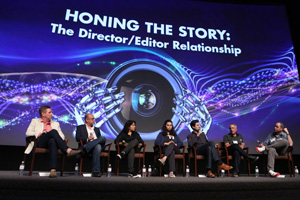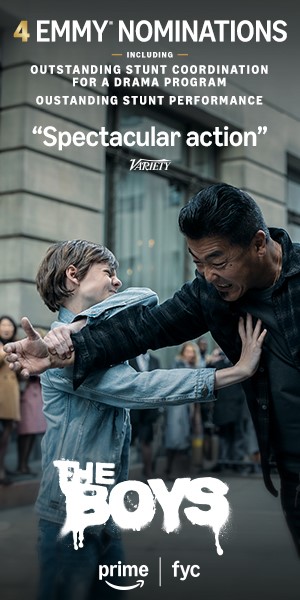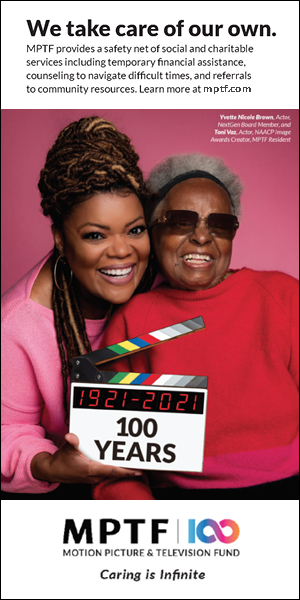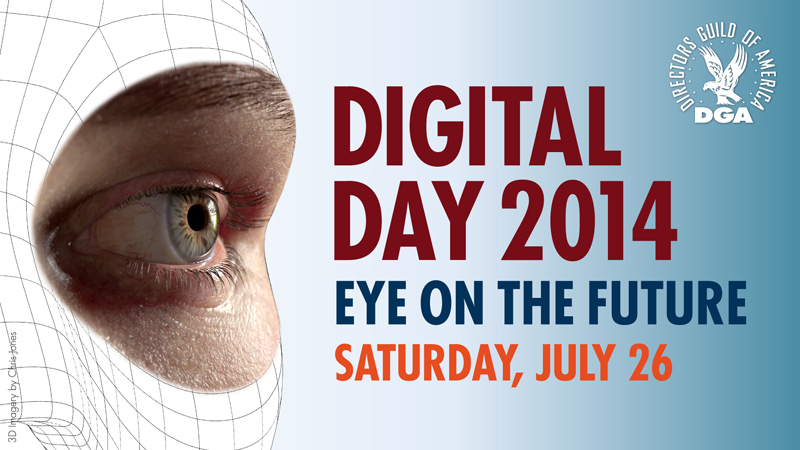photos by Howard Wise
250 DGA members joined other industry professionals for a day of learning and networking during the 15th annual Digital Day at the DGA. Held at the Guild’s Los Angeles Theater complex on July 29, the annual symposium of cutting-edge technologies featured presentations, exhibits, and much more. This year's event “Capturing Your Vision: Bringing the Story to Life” focused on the creative, technical and business issues surrounding new technologies and provided the opportunity for DGA members and guests to hear from experts in the field.
Digital Day commenced with the traditional welcome from the DGA Special Projects Committee Chair Jeremy Kagan (SHOT). Then Special Projects Digital Day Subcommittee Chair Randal Kleiser (Defrost) gave the audience a quick overview of the panel discussions and presentations that would be taking place in Theaters One and Two and urged attendees to take advantage of the hands-on demos in the lobby.
(See video from these welcomes in the gallery below.)
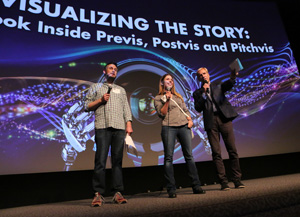 Visualizing the Story: A Look Inside Previs, Postvis & Pitchvis
Visualizing the Story: A Look Inside Previs, Postvis & Pitchvis
In the day’s first presentation in Theater One, Previs Supervisor Shannon Justison and Head of Virtual Production Casey Schatz from The Third Floor revealed how previs, postvis, technical planning and on-set visualization helped sync up the live action and animation sequences on Director Bill Condon’s Beauty and the Beast.
Since launching her career as part of the animation team at DNA Productions for Nickelodeon’s The Adventures of Jimmy Neutron: Boy Genius, Justison has amassed credits that include Guy Ritchie’s King Arthur: Legend of the Sword, Joss Whedon’s Avengers: Age of Ultron, and Wes Ball’s The Maze Runner. Schatz, a recognized expert in emerging virtual production techniques for motion pictures and TV, has credits that include James Cameron’s Avatar, Ridley Scott’s The Martian, and the HBO mega-hit Game of Thrones.
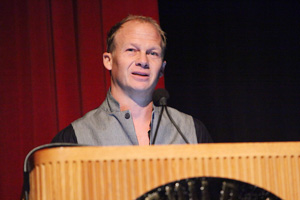 Then VFX Supervisor Tefft Smith II from Halon Entertainment discussed the breakdown of previs on Director James Mangold’s Logan, and how the pitchvis process on Director Noam Murro’s 300: Rise of an Empire expanded his freedom to shape and realize the story to his creative vision before cameras began rolling.
Then VFX Supervisor Tefft Smith II from Halon Entertainment discussed the breakdown of previs on Director James Mangold’s Logan, and how the pitchvis process on Director Noam Murro’s 300: Rise of an Empire expanded his freedom to shape and realize the story to his creative vision before cameras began rolling.
Smith has more than 17 years of experience as a 3D/VFX Supervisor with credits that include Marc Forster’s World War Z, Gary Ross’s The Hunger Games and Jordan Vogt-Roberts’s Kong: Skull Island. He also created bumpers of the 50 Greatest VFX Films and a Tribute to Steven Spielberg for the Visual Effects Society.
(See video from this presentation in the gallery below.)
Conceptualizing the Story: The Director's Vision
The next presentation was a panel discussion about how directors take a story from script to screen and what technology they rely on to bring the story to life. The panelists were Directors Peter Atencio (Jean-Claude Van Johnson), Uta Briesewitz (Black Sails) and Justin Simien (Dear White People) who engaged in a conversation about the possibilities available to filmmakers moderated by Director Jeremy Podeswa (Game of Thrones).
A DGA member since 2011, Atencio is best known for his work as the director and executive producer of the Peabody Award-winning show, Key and Peele (for which he won an Emmy for Outstanding Variety Sketch Series). His other credits include the feature film Keanu and the series Last Man on Earth.
Briesewitz earned a Primetime Emmy nomination in 2010 for Outstanding Cinematography for a Half-Hour Series for her work on HBO’s Hung, the series that also launched her directorial career. A DGA member since 2010, her other directing credits include Orange is the New Black, Jessica Jones, Fear the Walking Dead and The Deuce.
In 2014, Simien wrote and directed his first feature film, Dear White People, which earned him the Special Jury Award for Breakthrough Talent at the Sundance Film Festival. Recently, he adapted the film into a series for Netflix. Simien has been a DGA member since 2013.
Podeswa has earned three Emmy Award nominations for Outstanding Directing for a Dramatic Series for Boardwalk Empire and Game of Thrones and for Outstanding Directing for a Miniseries for HBO’s The Pacific (which also earned him a DGA Award nomination). A DGA member since 2001, some of his other credits include episodes of the series True Detective, The Newsroom, True Blood, Rome, Homeland, Ray Donovan, The Walking Dead; and the feature films Fugitive Pieces, The Five Senses and Eclipse.
(See video from this presentation in the gallery below.)
Tools for Production
Tools for Production: Academy Color Encoding System (ACES)
Digital Day attendees continued their learning with two presentations in Theater 2. In the first half of this program showcased how the Academy Color Encoding System (ACES) digital production standard can help filmmakers protect their creative vision by enabling consistent color from set to screen. The presentation was given by UPM Glenn S. Gainor who serves as Head of Physical Production at Screen Gems, AMPAS Science and Technology Council Managing Director Andy Maltz and VFX Supervisor Jake Morrison.
Maltz is the Managing Director of AMPAS’s Science and Technology Council where his responsibilities include representing the Academy on science and technology issues. He co-authored The Digital Dilemma and The Digital Dilemma 2, the Academy’s landmark reports on long-term preservation of digital motion pictures, and is the Project Director for the Academy Color Encoding System (ACES).
Morrison is a VFX supervisor and second unit director whose credits include visual effects for Peyton Reed’s Ant-Man, Joss Whedon’s The Avengers, Peter Jackson’s The Lord of the Rings: The Two Towers; and VFX and second unit directing work on Alan Taylor’s Thor: The Dark World and Taika Waititi’s Thor: Ragnarok. He has been a DGA member since 2013.
(See video from this presentation in the gallery below.)
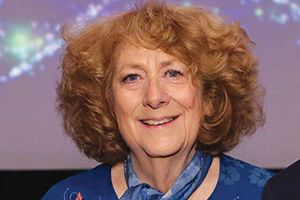 Tools for Production: Creative & Production Apps
Tools for Production: Creative & Production Apps
In the second half of this program, DGA AD/UPM VFX/Digital Technology Committee Chair Susan Zwerman gave an overview of creative and production apps for Directors and Director’s team members.
With credits on more than 50 major films, Zwerman has produced the visual effects for works such as Alien Resurrection, Around the World in 80 Days, Fat Albert, and The Guardian. She is also the co-author, with Charles Finance, of the manual, The Visual Effects Producer: Understanding the Art and Business of VFX. A DGA member since 1979, Zwerman received the 2013 Frank Capra Achievement Award in recognition of career achievement and service to the industry and to the Directors Guild of America.
Click here to download the 2017 Mobile Apps List
Enhancing the Story: A Dialogue between Directors & their VFX Teams
Following the lunch break, Directors Michael Goi (American Horror Story) and Richie Keen (Fist Fight) and VFX Supervisors Chris LeDoux (Fist Fight), Jason Piccioni (American Horror Story) and Brad Powell (CSI:NY) engaged in an in-depth conversation about the use of visual effects in television and features with a range in budgets with Directors and their VFX Supervisors. The panel was moderated by Director Oz Scott (CSI:NY).
A DGA member since 2014, Goi has helmed episodes of Pretty Little Liars, Famous in Love, Sleepy Hollow and Shadowhunters and the feature film Megan Is Missing. Currently serving as a Co-Chair of the DGA Asian American Committee, Goi has also compiled over 70 narrative credits and earned four Emmy nominations for his work as a cinematographer.
Keen, who joined the DGA in 2009, has credits that include episodes of It’s Always Sunny in Philadelphia, Shameless, The Comedians and Disjointed; and the award-winning ESPN 30 for 30 Shorts, “Tommy and Frank.” He is also set to direct the upcoming feature Partners.
LeDoux is a 15-year veteran of production and VFX with over 100 credits that include award-winning films such as Hidden Figures and the DGA Award-winning La La Land.
As an Emmy Award-winning VFX Supervisor, Piccioni has supervised high profile television projects for FuseFX including American Crime Story, Feud, Salem and Manhattan. He has also worked on a wide variety of pilots and features, including Alfonso Gomez-Rejon’s genre-bending fantasy thriller pilot, Citizen, for Hulu.
Powell, the owner of the boutique VFX and motion graphics house BLP, has credits that include Bull, Elementary, The Mindy Project, Doubt, Baskets, Incorporated, No Tomorrow and CSI: Cyber, among others. He has also been a DGA member since 2011 with second unit directing credits on CSI: NY.
Scott is an award-winning television, film and theatre director with more than three decades of experience. His more than 100 television directing credits include episodes of Agents of S.H.I.E.L.D., Criminal Minds, Boston Legal, The Practice, Hill Street Blues and The Jeffersons. He joined the Guild in 1978 and has also served as an alternate to the DGA Western Directors Council, was a Co-Chair of the African American Steering Committee, and currently serves as an alternate on the DGA’s National Board and is a member of the DGA Special Projects Committee and the Diversity Task Force.
(See video from this presentation in the gallery below.)
Honing the Story: The Director/Editor Relationship
The final panel discussion of the day took an inside look at how directors and editors work together to cut the story for the screen. The panel featured Director Mark Cendrowski and Editor Peter Chakos (The Big Bang Theory), Director Joseph Kosinski and Editor Billy Fox (Only the Brave: The Story of the Granite Mountain Hotshots) and Director Nisha Ganatra and Editor Eleanor Infante (You Me Her) in a conversation moderated by Director/Editor Gregory Plotkin (Paranormal Activity: The Ghost Dimension).
Cendrowski has been a DGA member since 1986 with credits that include episodes of Full House, King of Queens, Eight Simple Rules and the pilots for Dads, The Odd Couple and The Carmichael Show. Chakos has won three Emmys for his editing work on The Big Bang Theory and has edited 230 episodes of that series. He has also has been a DGA member since 1997 with credits on The Big Bang Theory, Caroline in the City and Pearl.
Kosinski, who joined the DGA in 2007, made his feature film debut with Tron: Legacy, and followed up with the science-fiction thriller Oblivion. Some of Fox’s other editing credits include Craig Brewer’s Hustle & Flow, John Singleton’s as Four Brothers and F. Gary Gray Straight Outta Compton.
Ganatra’s debut feature, Chutney Popcorn, won the Audience Award at the Berlin International Film Festival. She recently served as director and co-executive producer for Better Things, Transparent and the first season of You Me Her. A DGA member since 2007 her other directing credits include episodes of Brooklyn Nine-Nine, Girls, Mr. Robot and Shameless. As an editor, Infante has mainly worked in scripted television with credits that include episodes of include Comedy Central’s White Flight, Amazon’s Lore and Audience Network’s You Me Her.
Plotkin, a DGA member since 2014, also has editing credits that include Gregory Hoblit’s Untraceable, Tod Williams’s Paranormal Activity 2 and Jordan Peele’s Get Out. He is currently cutting John Francis Daley and Jonathan Goldstein’s Game Night.
(See video from this presentation in the gallery below.)
Hands-On Demos and Exhibits
In the DGA lobby, attendees were able to engage in hands-on demonstrations and exhibits such as:
- A demonstration of how using Academy Color Encoding System (ACES) gives consistent color from set to screen and allows you to communicate, achieve and protect your creative vision.
- A demonstration by Adobe on the most recent tools from Premiere Pro and how to transform 2D characters into live animations using Character Animator.
- A demonstration on the latest features in Avid’s creative editorial tools and Media Composer, now featuring ScriptSync and PhraseFind.
- A demonstration on CBS Digital’s pre-visualization, visual effects, and post-production creative services for television, feature films, and commercials.
- A demonstration by Cinema Devices on the AntigravityCam, which provides stability from floor to nine feet overhead without heavy counterweights or long set up times.
- A presentation by Exceptional Minds Studio, demonstrating the VFX and Animation skills of young artists on the autism spectrum.
- A demonstration by FuseFX on the latest in visual effects for episodic television and virtual reality.
- A demonstration by HALON Entertainment on expanding the limitations of your creative vision with pre-visualization.
- A demonstration by Home3D.us and Matterport on an all-in-one interactive reality capture system that helps individuals and crews interact with 3D models of real-life locations.
- A demonstration curated by the International Cinematographers Guild on examining volumetric capture and computational cinematography solutions designed to impact traditional image making and emerging forms of content.
- A demonstration by the International Cinematographers Guild on new tools and techniques for realizing your vision in both HDR and SDR.
- A demonstration by Reminiz on how to maintain audiences for VOD and live TV and increase ROI through onscreen content recognition, using AI-based facial recognition.
- A demonstration by Source Digital on how to utilize their multilayer monetization and engagement platform that personalizes in-screen brand and product experiences for TV, film, and digital content.
- A demonstration by SyncOnSet on their latest software that helps streamline production and cut days off of wrap.
- A demonstration by Valossa on AI technology that sees, hears and understands what's inside videos.
